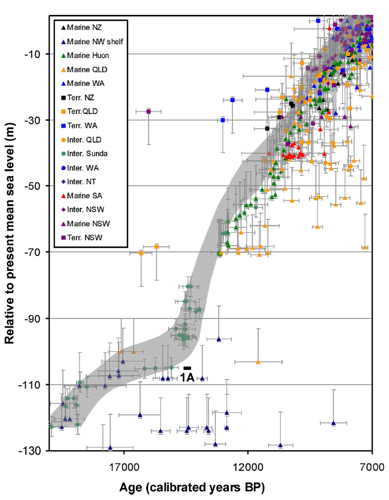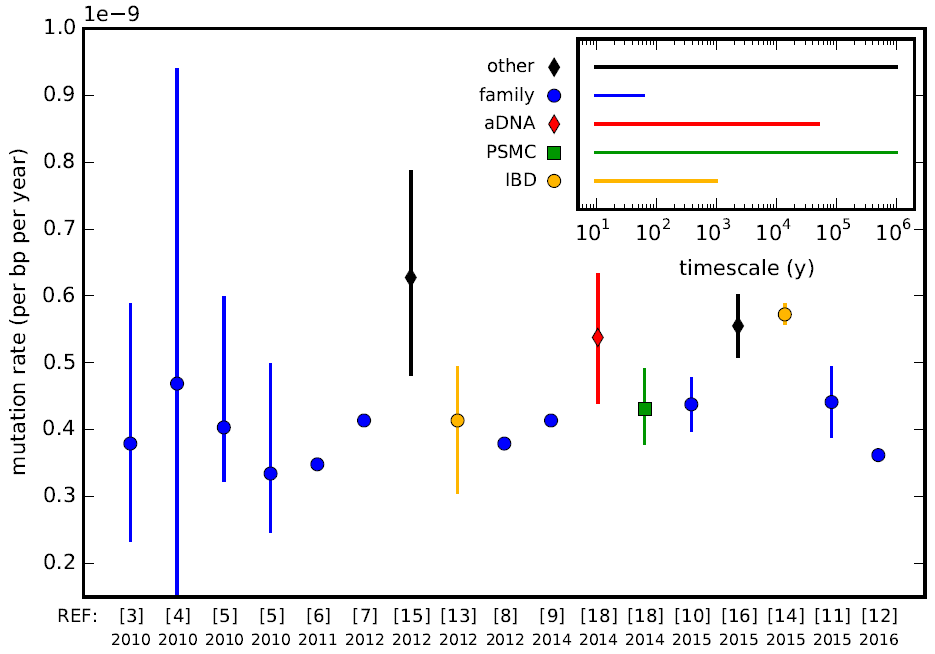Chris, as I recall, the percentage is very dependent on the methodology used to calculate it, so whether it is 89% or 98% is really irrelevant, unless you are using those numbers as a tool. In that case, they become useful. For example, it would be of interest to compare human to chimp, and chimp to gorilla, and chimp to orangutan to put it in context, but one isolated comparison tells you very little.
So a ‘faith’ to you is something that doesn’t have any evidence to support it? Or even worse even despite evidence to the contrary one still proposes their model by ‘faith.’
A special creation model like yours is a faith based model that doesn’t have any mechanisms or predictions beyond God just did stuff. I have showed you now multiple times the types of differences we see can be explained by random mutations among human to human and between human and chimpanzee. Did you not understand the graph that I put above?
So rather than responding to the substance of my post your are picking on a phrase that actually comes from your post. Please respond to the main question; how much difference is too much? From your reference it would seem that 5% difference (95% similarity) is already 4 times more than can be supported by evolution theory.
In which case 98% similarity is not evidence in favour of humans and chimps having a common ancestor within the last ~7 million years. Is that what you’re trying to say?
No, I am saying you have to compare apples to apples. 98% may be evidence, or may not depending on how it is determined, and how it compares to other animals using the same measure.
Skip the genome size and just calculate the rate of difference from the mutation rate and the approximate number of generations. The range is 0.76% to 1.29%.
You seem to have missed something. The range of single base differences is predicted to lie between 0.76% and 1.29% (roughly). The observed rate of single base differences between the species is 1.23%. To predict the total genetic difference between the species requires a good estimate of the mutation rate for insertions and deletions, including large ones, which we do not have. These mutations are less frequent than single-base substitutions but contribute more total sequence change.
Adam and Eve were incarnated as humans on Earth the first time about 200,000 years ago. But these early humans were hunters and often cannibals, as such they did not have much language or culture. This came much later.
It was the abrupt global warming that occurred around 8,500 BC, that flooded the inhabited delta regions and wiped out those who were not prepared for the rising waters. But Noah was warned enough in advance to be saved. Only after the hunters/cannibals were wiped out, was a farming/animal husbandry culture able to be established. This is where language and culture started to establish a civilization.

They were what?
And what do you think this graph is telling you about a massive rise in sea level? Presumably the black curve is the average temperature anomaly and I have no idea what the different colors are meant to represent but it doesn’t show anything related to a massive rise in sea level that would have killed all those barbaric hunter folks but preserved the more civilized like farmer Noah.
Here is a graph from Australia for example:
And from various parts of the world (South America/Central America/etc.):

There is no sudden spike at 8,500 years ago but a gradual rising of sea levels over several thousands of years.
The LDS (mormons) think like that. They believe we were all born in heaven an then incarnated afterwards. But wouldn’t be too surprise to learn that there are some other groups who think in this way and some might even be Christian (in the creed of Nicea 325 AD sense).
Obviously I have made it very clear that I do not agree with this – not with pre-existence and not with putting Adam and Eve that early.
That sounds possible. However, the Bible puts the flood around 2300 BC and puts Adam and Eve around 4000 BC. I think you can still take the story it tells pretty seriously if you think this isn’t literally accurate. But I see no reason to exclude the possibility that it is correct, so I would place these two events with a time range like 4,000-10,000 BC for Adam and Eve, and 2,300-8000 BC for the flood (a local one which wiped out early human civilization), or something like that.
Matthew, I did not say there was peak 8,500 years ago, but that the delta regions flooded 10,500 years ago, or 8,500 BC. Your graphs show a 120 meter rise in the level of the oceans, starting to accelerate15,000 years ago and ending 7,000 years ago. Yes, the flood could be placed anywhere in the is range, but never younger than 6,000 years ago. It is not the slow rise of the ocean that was deadly, but the flash flooding coming from the irregular release of water from the melting glaciers. Australia did not experience the dangers that the near east did in this respect. As the ice receded in Eurasia, the dearly regions were deadly.
The reference for the 8,500 BC number comes from the work of Heinz Blum. (“Erwaermung bewirkte die Sintflut.” Museion 2000,3/1994, 40-46. Print) This is based on many factors, including the oldest bricks found in the near east have been dated at 8,300 BC - the first signs of constructed civilization.
Dear Mitchell, the Bible does not say anything about time, but rather doctrine has created these dates that you are quoting. I thought that Biologos was the intersections between the Bible and Biology? Biology has dated the convergence of genetics to 100,000 to 200,000 years ago, with no fundamental change in genetics from then until now in humanity. Are you open to alternative interpretations of the numbers in the Bible that match what biology and anthropology are showing us?
Biology has done what? And why does ‘no change in genetics mean?’ Here is the measured mutation rate per base pair per year in modern humans:
Nothing in that statement is correct.
Steve, so you deny the results that show the convergence of genetics 100,000 to 200,000 years ago? Or does genetic research show that at some point in the past 200,000 years that human could live to be 930 years old? Certainly man has evolved somewhat over that time, but there have been no fundamental changes like there was at the bottleneck.
Thanks Matthew, I clarified my post to say “no fundamental change” in genetics since the bottleneck. Fundamental meaning to include aspects like lifespan.
Yes, I completely deny those results. Or rather, I deny the conclusion that the authors reach, because their conclusion does not follow from their data. It’s a really bad paper. A good sketch of the problems in the paper can be found here. I can explain in more detail if you like.
There is no trace of a hint anywhere in biology that humans could ever live to 930.
There is no evidence for a tight bottleneck anywhere in human history. (The global history of humans, that is. There’s abundant evidence for bottlenecks in particular populations.) In particular, a tight bottleneck within the last 200,000 years would have left clear traces in patterns of modern genetic diversity, and we don’t see those patterns.
Not sure if this has changed or follow studies have been done yet:
Thanks for pointing this out. It really can’t be said enough. What is more interesting and probably more relevant to these discussions are apples to apples comparisons of a number of species so that we can better understand what 97 or 95 or 88% means. YECs keep talking about 88% or even 75% similarity and I keep saying show us how similar you and I are, how similar a neanderthal and I are or a chimp and bonobo are using the exact same methodology so we have some perspective on what those similarity values means. I am always met with either silence or some sort of excuses about how we don’t have good enough genomes data to do these comparisons yet. To the latter I say, that is not really true but they could take a subset of a genome and do the same apples to apples to comparisons if they wanted to.
You are correct. Christians believe that we are ensouled creatures, but the LDS believe in a spiritual pre-existence, acquiring a body on earth afterwards. And they believe that blacks were given their color because they were less valiant in the pre-existence.

